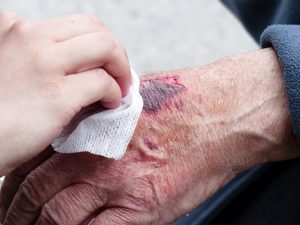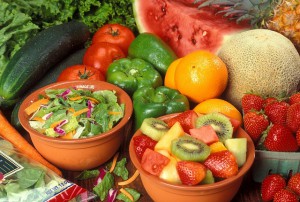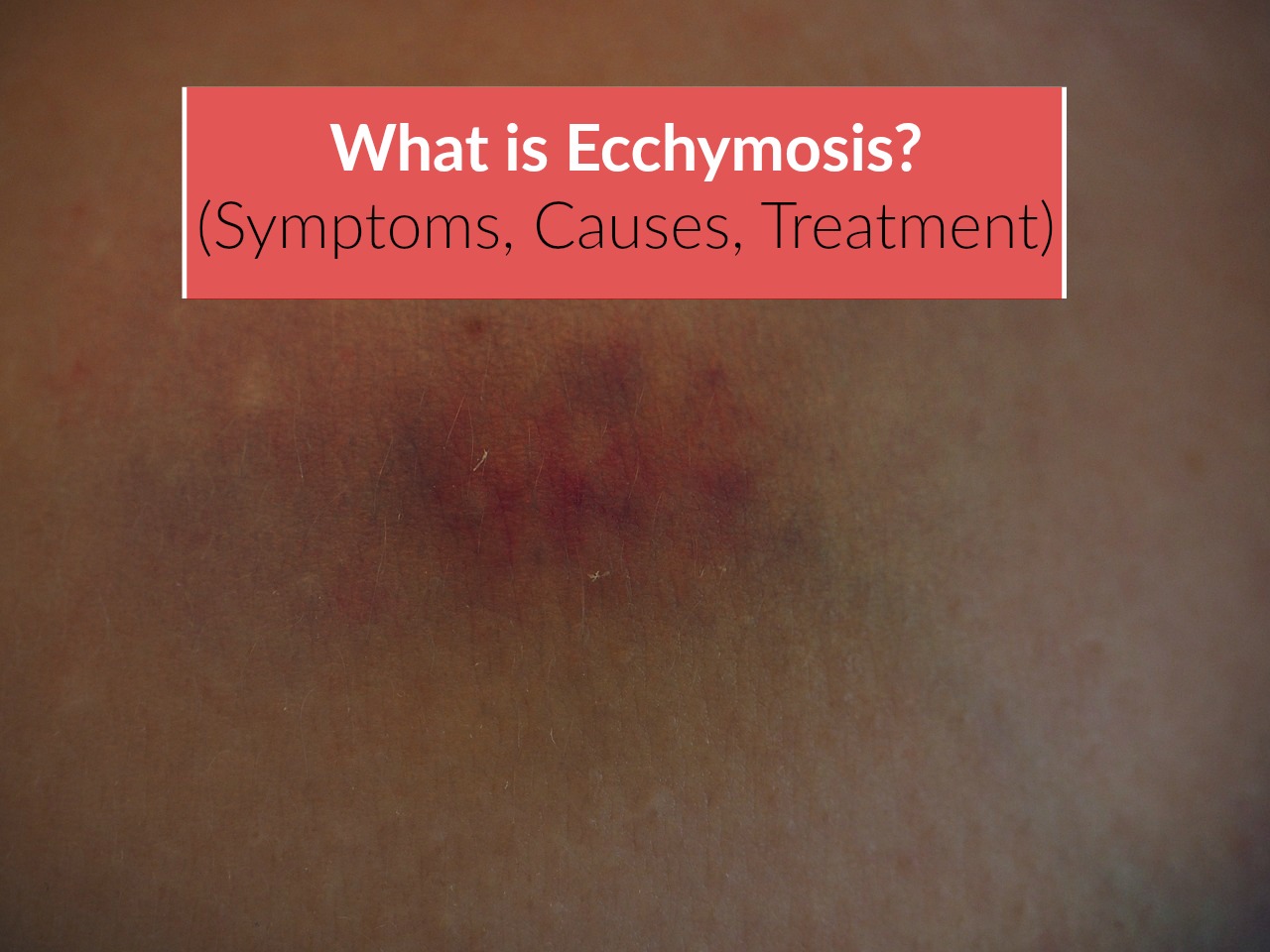According to the National Institutes of Health’s Web site, Ecchymosis (Skin spots – red; Pinpoint red spots on the skin; Petechiae) can be described as bleeding on the inner layers of the skin that cover a sizable area of the skin.(1)
Although many people use the words bruise and ecchymosis simultaneously to mean the same thing, there are considerable differences between them.
In most cases, this condition entails the loss of blood at a profound skin tissue level. When a small amount of blood seeps out into the tissue beneath the skin, mostly due to trauma, bruises may start to form.
Ecchymosis bruises usually change color with time from red to purple to yellow, and finally brown. The color changes may often occur over a period of one to four weeks before disappearing.
However, some faded discoloration may persist for several months for people with extreme bruising. Going through the right first aid procedure after an injury is your best shot in reducing purple bruising because it helps expedite the healing process.
In addition, the use of natural ingredients such as vitamin K and Arnica can help get rid of dark bruises through topical administration.(Gary Goldfaden, MD and Robert Goldfaden 2010)(2)
Symptoms
Bruising and Ecchymosis are the result of blood seeping out into the inner layers of skin due to damage to blood vessels on underlying layers of the skin.
However, the difference between normal bruising and ecchymosis does not only lie in the appearance of the skin after the injuries, but also in the areas where they occurred.
Normal bruising occurs on any area of the body including around the mucous membrane and in various body organs.
However, this condition occurs in mucous membranes and in the lean layers of the skin.(3) While ecchymosis possesses a single flat character, normal bruising has a three dimensional character.
There are several symptoms of ecchymosis, although some that may manifest may be linked to the existing condition that led to the development of ecchymosis.(4)
Some of the general symptoms of this condition include:(5,6)
» Burning sensation on the affected areas. However, some patients may not experience burning sensation on the affected areas of their skin
» Appearance of reddish or purplish patches on the skin with each patch covering a diameter of an inch or more
» Enlarging skin discoloration, mostly purplish or reddish in color
» Pain on the unaffected skin near the ecchymosis site. However, this is determined by the extent of tissue damage caused by this disorder
» Ecchymosis may also spread to areas adjacent to the affected parts of the skin depending on the seriousness and the location of ecchymosis
Ecchymosis Causes
 Ecchymosis is often considered harmless by many people because it is not a disorder or a condition. However, it may be a symptom of various underlying health complications that may require urgent medical attention.
Ecchymosis is often considered harmless by many people because it is not a disorder or a condition. However, it may be a symptom of various underlying health complications that may require urgent medical attention.
Skin spots may be a sign of an inflammatory reaction or a more complicated medical condition.
According to rightdiagnosis, generally, it is caused by blunt trauma that leads to rupture of blood vessels causing blood to leak into the inner layers of the skin around the mucous membrane or other affected parts of the skin.(7)
However, the blood leaking in the inner layers of the skin does not flow out of the skin because the outermost layer of the skin is still intact. Accumulation of blood within the skin layers causes the purplish or reddish discoloration.
Ecchymosis may also be caused by underlying medical conditions that cause skin capillaries to rupture.
Such medical conditions include:
Leukemia
Leukemia refers to the abnormal growth of the tissues that produce blood as well as the production of blood cells. Symptoms of leukemia include excessive bleeding when cut or injured and easy bruising, which are similar to symptoms of ecchymosis. The development of skin spots is influenced by a raise in white blood cells levels.
Acute renal failure
Acute renal failure is the speedy loss of the kidney’s function. When the kidney fails to perform its work of eliminating wastes from the body, harmful chemicals or agents start to accumulate in the body. Ecchymosis could be caused by the waste buildup caused by the acute renal failure.
Multiple myeloma
This is cancer that affects the plasma cells in the body. Myeloma is a type of white blood cells that are usually found in the bone marrow. Abnormal growth of the plasma cells in the bone marrow may cause Ecchymosis.
Liver cirrhosis
This disease is often characterized by the abnormal structure and function of the liver. Ecchymosis could be one of the health complications caused by liver cirrhosis.
Myelofibrosis
This refers to the development of an abnormal growth in bone marrow tissues. Fibrosis formation leads to interference in the normal production of the body’s blood cells.
Treatment
Mild cases of Ecchymosis usually heal on their own without the need for treatment. However, regular occurrence of red spots on the skin accompanied with pain could be a sign of a more serious health condition. Therefore, consider seeing a doctor if this is the case.
The treatment options for Ecchymosis are determined by the underlying health complications causing the disease.(8)
» Rest promotes healing of affected skin tissues. Many doctors recommend adequate rest for patients with Ecchymosis to help expedite the healing process
» Applying ice on the affected area promotes vasoconstriction of the broken vessels and prevents Ecchymosis from spreading to adjacent unaffected areas of the skin
» Painkillers such as ibuprofen and other types of analgesics can be used to ease the pain caused by Ecchymosis.
» Stretching exercises and light massage can help promote tissue repair. However, be careful when administering the massage as it may cause more damage to blood vessels and tissues
Foods That Help Ecchymosis Heal Faster
 According to HealWithFood these “natural foods can be used as a preventive cure for excessive bruising.”(9)
According to HealWithFood these “natural foods can be used as a preventive cure for excessive bruising.”(9)
Foods Rich in Vitamin C
Add more vitamin C foods to your diet to help promote tissue regeneration. The human body does not naturally produce this antioxidant, which is associated with repairing tissues and helping wounds to heal faster. Adding vitamin C rich foods to your diet can help expedite the healing process for Ecchymosis.
The recommended vitamin C intake is 90 milligrams per day for men and 75 milligrams per day for women. Examples of foods rich in vitamin C include unsweetened vitamin C-fortified drinks, low sodium tomato juice, spinach, green or red pepper, fresh pineapples, watermelons, and cantaloupe.
Foods Rich in Vitamin K
Another important nutrient that can help treat Ecchymosis is Vitamin K. Lack of this important vitamin can reduce the blood’s ability to clot quickly after experiencing a cut or a bruise. Vitamin K can help promote normal blood clotting, which can help treat Ecchymosis.
The recommended daily intake of vitamin K is 90 to 120 micrograms for adults. Examples of foods rich in vitamin K include leafy Swiss chard, spinach, kale, broccoli, pasta, olive oil, and canola oil.
Importance of Folate
Folate is a type of vitamin B that helps to promote quick healing of bruises including Ecchymosis. Folates such as folic acid are often recommended for patients with Ecchymosis to help promote quick recovery. This nutrient plays an important role in cell division and tissue regeneration.
The recommended daily dosage for folates is 400 grams for adults and less than 400 grams for minors. Pregnant women, people with malabsorption disorders, and alcoholics are some of the people at risk of folate deficiency. Consider adding nuts, fruits, legumes, and folic acid fortified foods to your diet.
Vitamin B-12 Food Selection
A diet with foods rich in vitamin B can help heal bruises and Ecchymosis faster. Vitamin-B foods promote the production of blood platelets, which play an important role in clotting. Lack of vitamin B is a common symptom of vegetarians, the elderly, and people suffering from anemia and gastrointestinal diseases.
The recommended intake for this nutrient is 2.4 micrograms for grownups. Examples of foods rich in vitamin B include eggs, chicken, low fat milk, fortified cereals, and fish.
Things You Can Do About Red Spots On The Skin
» If you develop a bruise on your skin, apply ice to the area for 20 – 30 minutes. The ice will help shrink and constrict damaged blood vessels (10)
» Use a heated compressor 2 or 3 times a day to help the body reabsorb the blood (11)
» Consider taking Acetaminophen (Tylenol) to help reduce the burning sensation around the affected area
» Avoid non-steroidal anti-inflammatory drugs if you experience bleeding because these drugs prolong bleeding and interfere with blood platelets (12)
» Notify your health specialist if you notice that you bleed or bruise easily to help determine a potential bleeding problem. Be honest with your doctor and tell him about any other medications that you have been taking including herbal remedies, over the counter drugs, and supplements. Do not forget to mention to your doctor if you have a history of diabetes, liver, heart, and kidney disease
» Unless specifically instructed by your doctor, do not consume aspirin (acetylsalicylic acid) or products that contain aspirin (13)
» Your doctor may prescribe additional medication to help treat an underlying medical condition that is causing the bleeding or Ecchymosis
Conclusion
Ecchymosis is a treatable condition that affects people from different age groups, lifestyles, and cultures.
However, athletes and people with underlying health complications such as anemia are most at risk of having red spots on the skin.
Consider seeing your doctor to help you determine the cause and treatment options for this condition.
References
(1)https://medlineplus.gov/ency/article/003235.htm
(2)http://www.lifeextension.com/magazine/2010/9/heal-traumatic-degenerative-skin-lesions-naturally/page-01
(3)https://books.google.com/books?id=PhdtLQVtCMMC&redir_esc=y
(4)http://www.ncbi.nlm.nih.gov/pubmed/24095269
(5)http://www.medicinenet.com/bruises/page2.htm
(6)https://deepblue.lib.umich.edu/bitstream/handle/2027.42/37732/1780200415_ftp.pdf;sequence=1
(7)http://www.rightdiagnosis.com/symptoms/ecchymosis/common.htm
(8)https://clinicaltrials.gov/ct2/show/NCT02319954
(9)http://www.healwithfood.org/bruises/
(10)http://www.thenakedscientists.com/HTML/questions/qotw/question/3474/
(11)http://www.healthcentral.com/encyclopedia/hc/hematoma-3168447/
(12)http://www.wfh.org/en/page.aspx?pid=639
(13)https://en.wikipedia.org/wiki/Aspirin
Leave Feedback: Was this article helpful?

